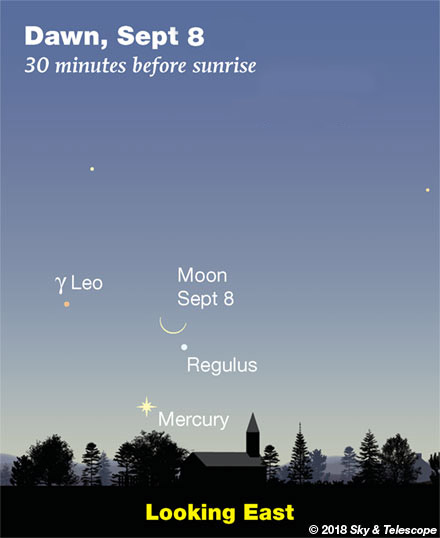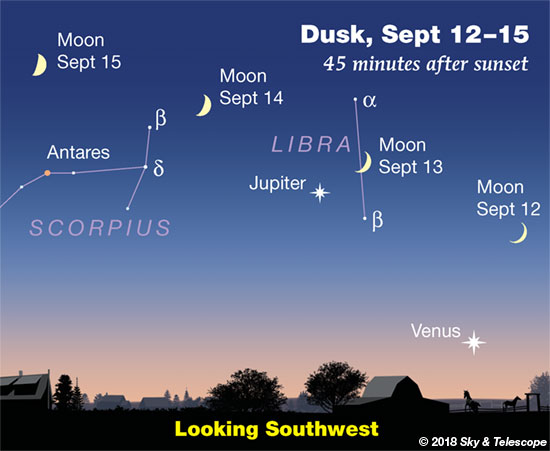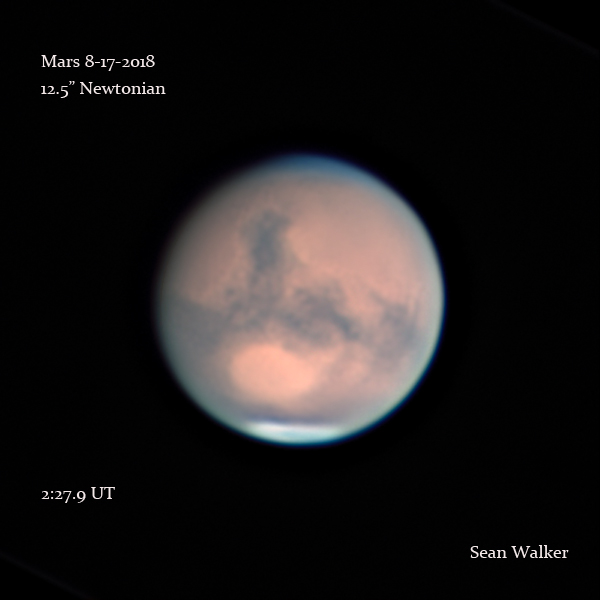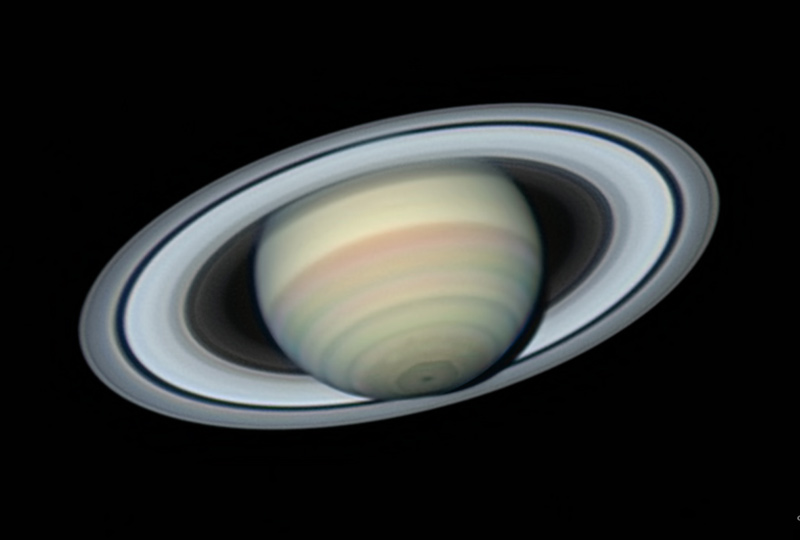Friday, September 7
• Hey there, fellow skywatchers! Four bright planets still shine during twilight this week, though one is getting very low and tricky. From right to left, they are Venus very low in the west-southwest, Jupiter upper left of Venus, Saturn higher in the south, and Mars well to the left of Saturn. Best viewing time that includes Venus: 30 or 40 minutes after sunset.
• Neptune is at opposition.

Saturday, September 8
• The two brightest stars (not planets) of September evenings are Vega high overhead and Arcturus in the west. Both are magnitude 0.
Draw a line down from Vega to Arcturus. A third of the way down you cross the dim Keystone of Hercules. Two thirds of the way you cross the dim semicircle of Corona Borealis with its one modestly bright star: Alphecca, the gem of the crown.
Sunday, September 9
• Mars shines fire-color in the south-southeast after dusk. High above it, by three or four fists at arm's length, sparkles white Altair.
And a finger width above Altair is fainter Tarazed, an orange giant much more luminous than Altair but 22 times farther in the background.
• New Moon (exact at 2:01 p.m. Eastern Daylight Time).
Monday, September 10
• Before the Moon comes back into the evening sky later this week, make the most of observing the Milky Way in however dark a sky you have. When Deneb crosses your zenith in mid-evening, you know the Milky Way does too — running straight up from the southwest horizon and straight down to the northeast horizon.
Tuesday, September 11
• Vega now passes the zenith an hour after sunset during late twilight, for those of us at mid-northern latitudes. It's bigger, hotter, and 50 times brighter than our Sun. But at 25 light-years, it's 1.6 million times farther away.
Wednesday, September 12
• The wide W pattern of Cassiopeia is tilting steeply up in the northeast these evenings. Look below the W's bottom segment, by a little farther than the segment's length, for an enhanced little patch of the Milky Way's glow if you have a dark enough sky. Binoculars will show it to be the Perseus Double Cluster — even through a fair amount of light pollution.
Thursday, September 13
• Low in the west-southwest as the stars come out, the waxing crescent Moon, Jupiter, and faint (3rd-magnitude) Alpha Librae form an almost perfect equilateral triangle 4° on a side (as seen from the middle of North America; less equilateral at dusk elsewhere).

Friday, September 14
• In twilight, catch the crescent Moon in the southwest with Jupiter to its lower right, as shown here. A line from the Moon through Jupiter points toward Venus, much lower.
Saturday, September 15
• The Moon hangs over Antares at nightfall, as shown here. Far to the Moon's left are Saturn, then Mars. To the Moon's lower right is Jupiter. And look far to Jupiter's lower right to catch Venus before it sets.
• Early on the Sunday morning the 16th, a 7.2-magnitude star in Taurus will be occulted for up to 5 seconds by the faint (12th-magnitude) asteroid 80 Sappho, along a shadow track running from central California to Maine. Details, map, and finder charts.
________________________
Want to become a better astronomer? Learn your way around the constellations! They're the key to locating everything fainter and deeper to hunt with binoculars or a telescope.
This is an outdoor nature hobby. For an easy-to-use constellation guide covering the whole evening sky, use the big monthly map in the center of each issue of Sky & Telescope, the essential guide to astronomy.

Once you get a telescope, to put it to good use you'll need a detailed, large-scale sky atlas (set of charts). The basic standard is the Pocket Sky Atlas (in either the original or Jumbo Edition), which shows stars to magnitude 7.6.
Next up is the larger and deeper Sky Atlas 2000.0, plotting stars to magnitude 8.5; nearly three times as many. The next up, once you know your way around, are the even larger Interstellarum atlas (stars to magnitude 9.5) and Uranometria 2000.0 (stars to magnitude 9.75). And read how to use sky charts with a telescope.
You'll also want a good deep-sky guidebook, such as Sue French's Deep-Sky Wonders collection (which includes its own charts), Sky Atlas 2000.0 Companion by Strong and Sinnott, or the bigger Night Sky Observer's Guide by Kepple and Sanner.
Can a computerized telescope replace charts? Not for beginners, I don't think, and not on mounts and tripods that are less than top-quality mechanically (meaning heavy and expensive). And as Terence Dickinson and Alan Dyer say in their Backyard Astronomer's Guide, "A full appreciation of the universe cannot come without developing the skills to find things in the sky and understanding how the sky works. This knowledge comes only by spending time under the stars with star maps in hand."
This Week's Planet Roundup


Mercury is dropping very low in the glow of sunrise.
Venus (magnitude –4.7) shines low in the west-southwest in evening twilight and sets before twilight is over. Find it lower right of Jupiter; their separation diminishes from 20° to 16° this week.
In a telescope Venus is a crescent about 1/3 sunlit and 33 arcseconds tall. For better telescopic seeing, catch it higher in blue sky long before sunset.
Mars, between Capricornus and Sagittarius, fades from magnitude –1.9 to –1.7 this week, still brighter than Sirius. Mars shines at its highest in the south for the two hours after dark.
In a telescope it shrinks from 20 to 18½ arcseconds wide this week . The dust in the Martian atmosphere continues to settle, allowing better views of surface markings. For a Mars map that shows which side is facing Earth at your time and date, use our Mars Profiler.
Jupiter (magnitude –1.9, in Libra) shines in the southwest in twilight, lower every week. In a telescope, Jupiter has shrunk to 34 arcseconds wide.
Saturn (magnitude +0.4, above the spout-tip of the Sagittarius Teapot) glows yellow in the south at nightfall, well to the right of brighter Mars.
Uranus is easy in binoculars at magnitude 5.7 near the Aries-Pisces border — if you have a finder chart and know the constellations well enough to use it.
Neptune (at opposition September 7th) is harder at magnitude 7.8, in Aquarius. By late evening they're well up in the east and southeast, respectively. Finder charts for Uranus and Neptune, or see the September Sky & Telescope, page 48.
______________________
All descriptions that relate to your horizon — including the words up, down, right, and left — are written for the world's mid-northern latitudes. Descriptions that also depend on longitude (mainly Moon positions) are for North America.
Eastern Daylight Time (EDT) is Universal Time (also called UT, UTC, GMT, or Z time) minus 4 hours.
______________________
"Remember to look up at the stars and not down at your feet. Try to make sense of what you see and wonder about what makes the universe exist. Be curious."
— Stephen Hawking, 1942–2018
______________________
"The dangers of not thinking clearly are much greater now than ever before. It's not that there's something new in our way of thinking, it's that credulous and confused thinking can be much more lethal in ways it was never before."
— Carl Sagan, 1996
______________________
"Objective reality exists. Facts are often determinable. Vaccines save lives. Carbon dioxide warms the globe. Bacteria evolve to thwart antibiotics, because evolution. Science and reason are not a liberal conspiracy. They are how we determine facts. Civilization's survival depends on our ability, and willingness, to do this."
— Alan MacRobert, your Sky at a Glance editor
______________________
"Facts are stubborn things."
— John Adams, 1770
 0
0








Comments
You must be logged in to post a comment.